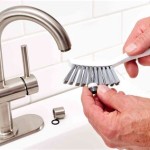Bathroom Glass Splashback Ideas: Elevating Style and Functionality
Bathroom design has evolved significantly, moving beyond purely utilitarian spaces to become areas that reflect personal style and contribute to overall home aesthetics. One element that has gained considerable popularity in modern bathroom renovations is the glass splashback. Offering a sleek, contemporary alternative to traditional tiles, glass splashbacks provide a multitude of design possibilities, enhancing both the visual appeal and practicality of the bathroom.
A splashback serves the primary function of protecting the wall space behind sinks, bathtubs, and showers from water damage and staining. Glass splashbacks excel in this role due to their non-porous nature, which prevents water absorption and the growth of mold and mildew. This makes them a hygienic and low-maintenance option for bathrooms, requiring only a simple wipe-down to maintain their pristine appearance.
Beyond functionality, glass splashbacks offer unparalleled design flexibility. They can be customized in terms of color, texture, size, and shape, allowing homeowners to create a truly unique bathroom space. This article explores various bathroom glass splashback ideas, examining the different styles, materials, and design considerations to help inform renovation decisions.
Choosing the Right Type of Glass
The selection of glass type is a fundamental consideration when planning a glass splashback installation. Different types of glass offer varying performance characteristics, impacting the final aesthetic and functionality of the splashback. The most common glass types used for bathroom splashbacks are:
Toughened Glass: Also known as tempered glass, toughened glass is a safety glass that is significantly stronger than standard annealed glass. It is manufactured through a process of extreme heating and rapid cooling, which creates a compressive stress on the surface of the glass. This makes it resistant to impact and thermal shock. If broken, toughened glass shatters into small, blunt fragments, reducing the risk of serious injury. This makes it a particularly suitable choice for areas where impact is likely, such as near sinks or in showers.
Low-Iron Glass: Standard glass contains iron, which can impart a slight green tinge to the glass, especially noticeable in lighter colors or clear glass. Low-iron glass, as the name suggests, contains a reduced amount of iron, resulting in a clearer, more neutral appearance. This is particularly beneficial when using light paint colors or when aiming for a true representation of the chosen color. Low-iron glass is often preferred for its premium aesthetic.
Laminated Glass: Laminated glass consists of two or more layers of glass bonded together with an interlayer of polyvinyl butyral (PVB). This interlayer holds the glass fragments together if the glass is broken, preventing it from shattering and falling apart. Laminated glass also offers enhanced sound insulation and UV protection. While not as commonly used as toughened glass for splashbacks, it can be a viable option for larger splashback installations or where additional safety is desired.
The thickness of the glass is another important factor to consider. Thicker glass generally provides greater strength and stability, especially for larger splashbacks. A minimum thickness of 6mm is generally recommended for bathroom splashbacks, with thicker options available for larger installations or where increased durability is required.
Exploring Design Possibilities: Colors, Finishes, and Patterns
One of the most appealing aspects of glass splashbacks is the wide range of design options available. From bold, vibrant colors to subtle, neutral tones, the possibilities are virtually limitless. Furthermore, different finishes and patterns can be incorporated to create unique and visually appealing splashbacks.
Color: The color of the glass splashback can significantly impact the overall ambiance of the bathroom. Light colors, such as white, cream, and pastel shades, can create a bright and airy feel, making the bathroom appear larger and more spacious. Dark colors, such as navy blue, charcoal gray, and black, can add a touch of drama and sophistication to the space. Choosing a color that complements the existing bathroom fixtures and décor is crucial for achieving a cohesive and harmonious design. Color matching services are often available, allowing homeowners to precisely match the splashback color to other elements in the room, such as wall paint or cabinetry.
Finish: The finish of the glass splashback can also contribute to its overall aesthetic. A standard glossy finish is the most common option, providing a smooth, reflective surface that enhances the sense of light and space. Matte finishes, on the other hand, offer a more subtle and understated look, reducing glare and creating a softer ambiance. Satin finishes provide a balance between gloss and matte, offering a smooth, non-reflective surface with a slight sheen. Textured glass finishes, such as frosted or etched glass, can add visual interest and provide a degree of privacy, particularly in shower areas.
Patterns: Patterns can be incorporated into glass splashbacks in several ways, adding a unique and personalized touch to the bathroom. Printed glass splashbacks allow for the application of any image or design, from subtle geometric patterns to bold, abstract artwork. Digital printing technology allows for high-resolution images to be transferred onto the glass surface, creating a durable and visually stunning splashback. Another option is to use colored glass fragments or tiles to create a mosaic pattern. This involves embedding small pieces of colored glass into the splashback, creating a textured and visually dynamic surface.
Consider incorporating metallic elements into the splashback design for a touch of luxury. Gold, silver, or copper leaf can be applied to the back of the glass, creating a shimmering effect that adds depth and dimension to the space. This is particularly effective in bathrooms with a classic or opulent design style. Furthermore, backlighting can be used to enhance the visual impact of the splashback. LED strip lighting can be installed behind the glass, creating a soft and ambient glow that highlights the color and texture of the splashback. This can be particularly effective in bathrooms with limited natural light.
Installation and Maintenance
Proper installation is crucial for ensuring the longevity and performance of a glass splashback. While some experienced DIYers may be able to install a splashback themselves, it is generally recommended to hire a professional installer to ensure a flawless and secure fit. A professional installer will have the necessary tools and expertise to accurately measure and cut the glass, prepare the wall surface, and apply the adhesive correctly.
The installation process typically involves the following steps:
- Measurement and Cutting: The installer will take precise measurements of the area where the splashback will be installed. The glass will then be cut to the exact dimensions, taking into account any cutouts for outlets, pipes, or other fixtures.
- Surface Preparation: The wall surface must be clean, dry, and smooth before the splashback can be installed. Any imperfections or unevenness in the wall surface must be addressed to ensure a proper bond between the glass and the wall.
- Adhesive Application: A specialized adhesive designed for glass splashbacks will be applied to the back of the glass. The adhesive must be applied evenly to ensure a strong and durable bond.
- Placement and Securing: The splashback will be carefully placed against the wall, ensuring that it is aligned correctly. The splashback will then be secured in place using temporary supports until the adhesive has fully cured.
- Sealing: Once the adhesive has cured, the edges of the splashback will be sealed with a waterproof sealant to prevent water from penetrating behind the glass.
Maintaining a glass splashback is relatively simple. Regular cleaning with a soft cloth and a mild detergent is usually sufficient to remove dirt and grime. Avoid using abrasive cleaners or scouring pads, as these can scratch the surface of the glass. For stubborn stains or watermarks, a solution of vinegar and water can be used. Simply spray the solution onto the glass, let it sit for a few minutes, and then wipe clean with a soft cloth. Ensure the sealant around the edges of the splashback is inspected periodically and re-applied if necessary to maintain a watertight seal.
Glass splashbacks offer a stylish and practical solution for bathroom renovations. By carefully considering the type of glass, design options, and installation process, homeowners can create a bathroom space that is both visually appealing and functional. The durability, ease of maintenance, and design flexibility of glass splashbacks make them an excellent investment for any bathroom.

Four Stunning Glass Splashback Ideas For Your Bathroom Makeover Decoglaze

Bathroom Glass Splashback Ideas

Bathroom Glass Splashback Ideas

Four Stunning Glass Splashback Ideas For Your Bathroom Makeover Decoglaze

Shower Splashbacks Creoglass Design

Four Stunning Glass Splashback Ideas For Your Bathroom Makeover Decoglaze

Bathroom Glass Splashback Ideas

Dusk On The Water Contemporary Art Bathroom Sink Glass Splashback Small Wash Basin Red Dog Design

Bathroom Splashback Ideas Coloured Glass Splashbacks

Four Stunning Glass Splashback Ideas For Your Bathroom Makeover Decoglaze
Related Posts







